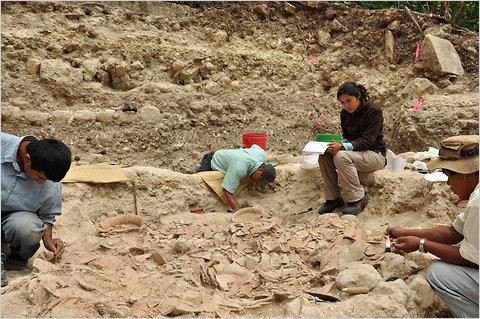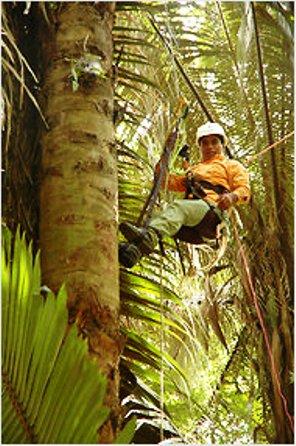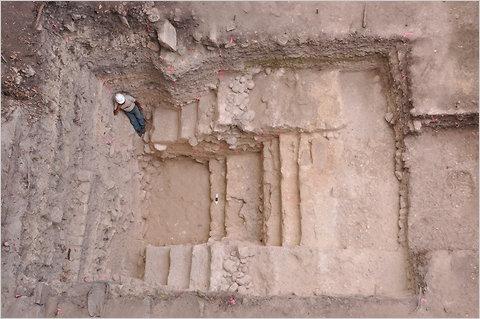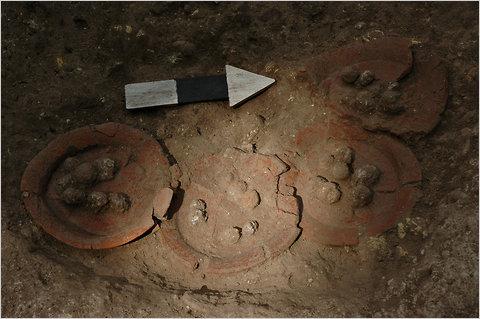Ceibal, Part-7 - Perils of the Rain Forest
Takeshi Inomata
Source - http://scientistatwork.blogs.nytimes.com/2011/03/09/perils-of-the-rainforest/

Takeshi Inomata - Flory Pinzón and colleagues excavating a large cache of broken ceramic vessels.
I would like to thank readers for being concerned about our safety. I assure you that the safety of our crew is our first priority. Most of the Preclassic construction fills at Ceibal, made of limestone-derived soils with high clay contents, have an almost cementlike quality. Those soil layers are difficult to excavate, as they are sometimes as hard as the ceramics that we try to extract, but they make very solid and stable excavation walls. We can even tunnel through those fills safely. To them, we add three types of reinforcements depending on their conditions: consolidation with lime mortar, braces with wood planks, and covers of wire nets. Daniela’s pit (shown in a previous post) is extensively consolidated with lime mortar.
Our larger concerns are the perils of the rain forest. Unlike the excavations, which we can control, nature constantly surprises us, demanding our respect. These threats range from mild ones like mosquitoes to more serious ones. Mosquitoes are vectors of malaria and dengue fever, and are a major nuisance, so Dani makes sure everybody is on a regular chloroquine schedule. Located on a river, Ceibal is known for an abundance of these bloodsucking insects, particularly during the rainy season (May to December). The repellent that we used, bottle after bottle, did little to help. Kazuo Aoyama brought electric-powered repellent dispensers from Japan, but it turns out that Guatemalan mosquitoes have no respect for Japanese technology. We had no choice but to adopt the local remedy — producing a profuse amount of smoke by burning palm nuts. Luckily, we are able to work in the dry season this year.
Many people would probably worry about poisonous snakes, tropical diseases and parasites. True, fer-de-lances are highly dangerous, and flesh-eating leishmaniasis is quite nasty. But what we fear most are the omnipresent trees that make up the forest. In a fierce competition for the sunlight, tropical trees extend their trunks and branches to their limits, and from time to time they fail, throwing their tremendous weight to the ground.

Takeshi Inomata - Santi wearing modern climbing gear.
One afternoon in 2010, strong gusts suddenly hit the site, knocking off a huge branch over the excavation unit where our Guatemalan student, Flory Pinzón, was working. Flory was unhurt, but badly shaken. As we are not allowed to cut trees in this protected forest, we try to reduce this risk by taking out dead branches over our excavations. For this, we rely on the local Q’eqchi’ Maya Spider-Man, Santi. He can climb trees with simple ropes or without any gear at all. Moving through branches, he detects and removes potential dangers.
Nature threatens but also helps us. Over the years, Santi and the old chicleros (those who used to collect chicozapote tree saps used for chewing gum production) taught me tree-climbing techniques, and I began to appreciate the presence of those giants by our excavation units. We can take photographs of excavations from trees and set up pulleys from their branches for hauling dirt. A few years ago, I decided that I was getting too old for Santi’s minimalist climbing techniques, but modern climbing gear still allows me to enjoy those vantage points. As Flory’s excavation grows larger, the same tree that once threatened her gives us an excellent perspective for excavation shots.

Takeshi Inomata - Flory Pinzón’s excavation, photographed from a tree.
Flory is a slender woman with flowing black hair. She holds a true spirit of a fieldworker. She can walk to a distant site daily with snake guards on. Even the tree incident did not stop her. The next morning she returned to her unit as if nothing happened and resumed business as usual under the same tree.
And this excavation in front of the large eastern pyramid of the Central Plaza rewarded her with some of the most spectacular finds in our project. In 2009, we found seven remarkable caches of ceramic vessels dating to the end of the Preclassic period, around A.D. 100. This was a time of major social change, with some centers being abandoned and new powers with formal rulership emerging. These offerings must have been of special importance to the Preclassic Maya who lived during an era of instability. These deposits were made sequentially, which might have been related to calendrical rituals.

Takeshi Inomata - Some of the vessels contained enigmatic stone spheres.
In the following season, Flory expanded the excavation and discovered the largest of all caches, containing nearly 100 vessels. Layer by layer Flory drew ceramics that had been crushed under the pressure of stones. It took her four weeks to go through this large deposit. It is now clear that forms of ritual deposits changed from ax caches in the early period to offerings of ceramic vessels toward the end of the Preclassic period. Despite this change, the Central Plaza continued to be the primary stage for community ritual.
With the Late Preclassic caches all excavated, Flory is now approaching the earliest part of the plaza fill. As their Late Preclassic descendants did, the earliest settlers of Ceibal might have used the eastern part of the Central Plaza as the main focus of ritual deposits. Does the area contain ax caches even more important than the ones we have found so far? Flory is about to find out.